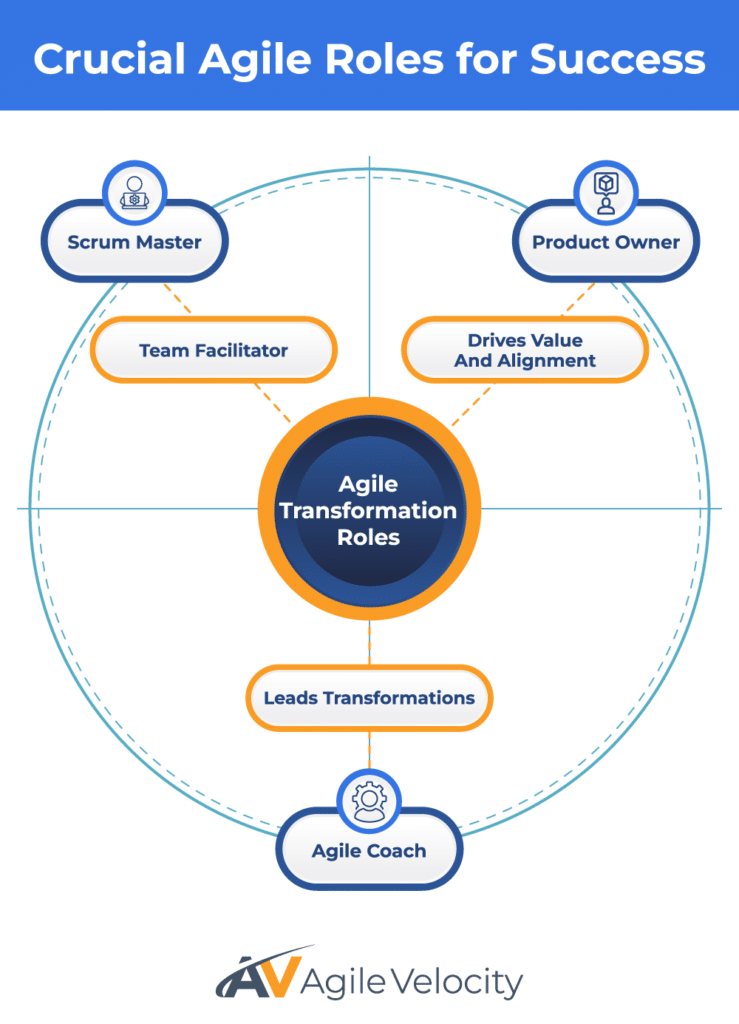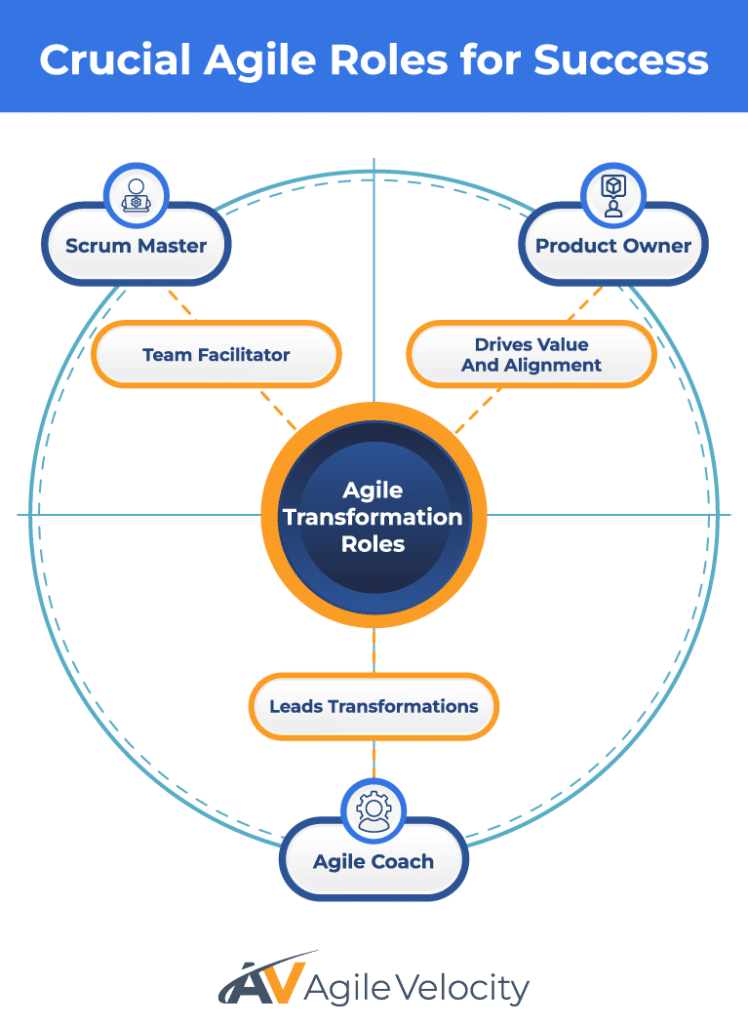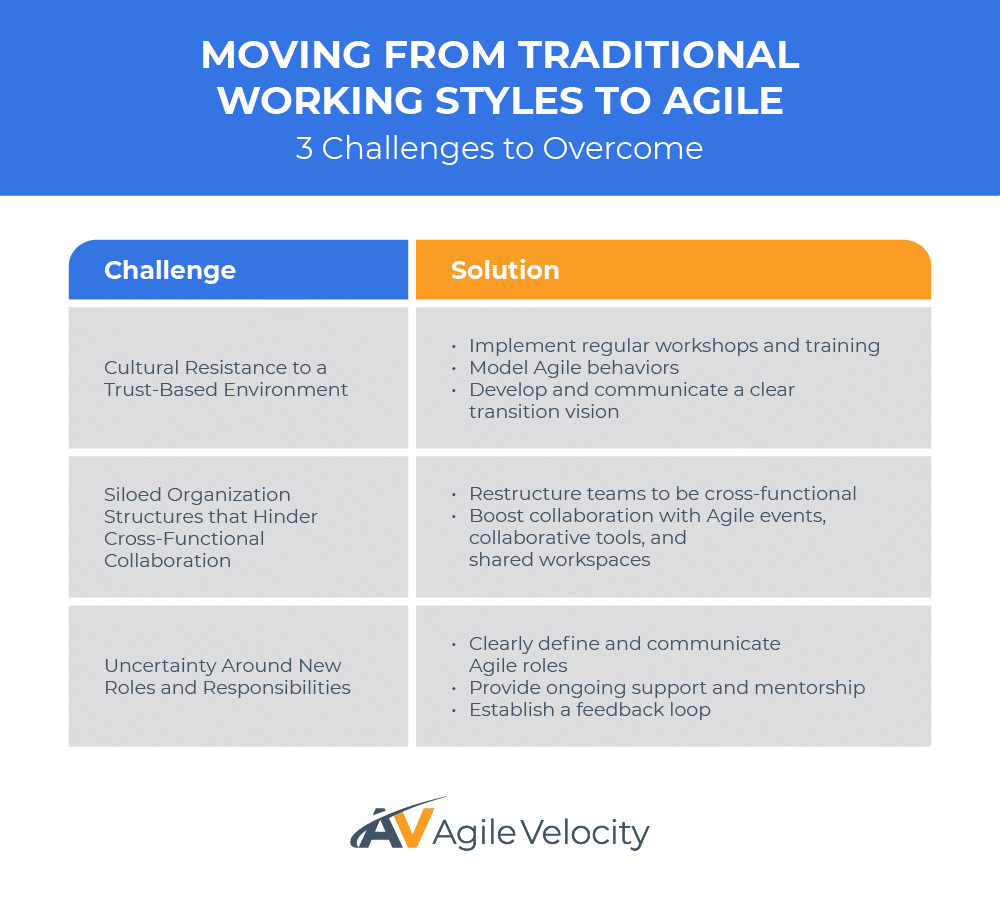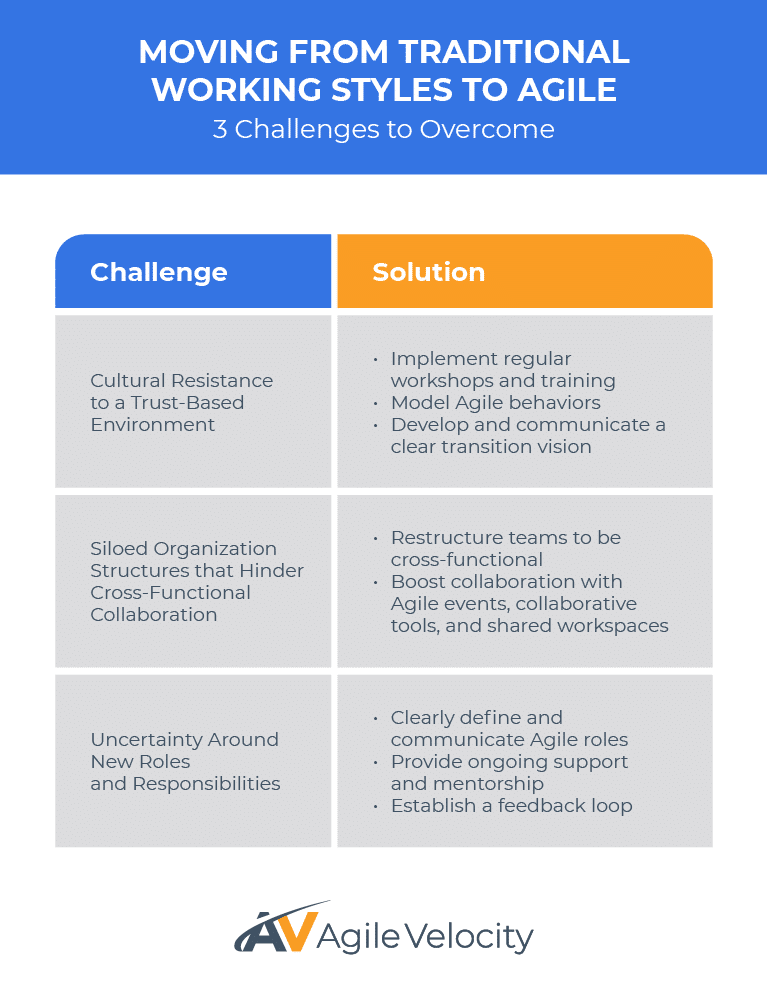Agile Transformations are essential for organizations striving to stay ahead of market changes and evolving customer needs. While tools and frameworks play their part, the backbone of any Agile initiative lies in having the right people in key roles.
This article explores the essential Agile roles your organization must hire to achieve successful Agile Transformations, foster organizational agility, and unlock the full potential of Agile practices. From defining core roles such as Scrum Master, Product Owner, and Agile Coach, to discussing supportive positions like Development Team Members and Business Analysts, this article provides a focused roadmap for staffing your Agile journey.
Additionally, we highlight how Agile Velocity can support your hiring needs by helping you connect with top-tier talent and how Path to Agility® Navigator offers clear visibility into transformation activities to ensure alignment with business objectives. Let’s explore how these roles contribute to sustainable success, and why they are crucial for creating a resilient, adaptable organization.
Introduction to Agile Roles for Business Success
Agile is more than a methodology—it’s a mindset. Success in Agile hinges on having the right people performing clearly defined roles and collaborating to achieve shared goals. Whether following Scrum, Kanban, SAFe®, or any other Agile framework, these clearly defined roles ensure alignment, accountability, and adaptability.
Hiring for essential roles supports a crucial cultural shift. Skilled professionals empower teams to organize around outcomes and operate autonomously, reducing the need for heavy top-down management. This alignment fosters trust and positions the organization for enduring growth.


Scrum Master: The Team Facilitator
The Scrum Master acts as a servant leader who fosters collaboration and continuous improvement. Rather than managing the team in a traditional sense, the Scrum Master empowers team members and ensures adherence to Agile principles.
Primary Responsibilities
Key responsibilities include:
- Facilitating Agile events such as Sprints, Sprint Planning, Sprint Review, and Sprint Retrospective.
- Identifying and removing impediments that disrupt the workflow.
- Coaching the team and stakeholders on Agile values and best practices.
- Encouraging self-organization and accountability within the Scrum Team.
A well-rounded Scrum Master drives a culture of continuous learning and helps the team deliver results efficiently.
What to Look for When Hiring a Scrum Master
Key attributes include:
- Strong communication and coaching skills to foster transparency and guide effective collaboration.
- Conflict resolution expertise to maintain team harmony.
- Versatility across the Scrum framework, as well as other frameworks such as Large-Scale Scrum (LeSS), Kanban, and XP, to ensure they have the knowledge to adapt as needed.
Hiring an effective Scrum Master creates the stability and focus essential for Agile success.
Product Owner: Driving Value and Alignment
The Product Owner ensures that the team’s efforts align with strategic goals and maximize customer value. Serving as the primary connector between business stakeholders and the Development Team, the Product Owner sets and refines priorities to deliver optimal outcomes.
Core Responsibilities
Key responsibilities include:
- Managing the Product Backlog by refining and prioritizing items based on business needs and customer feedback.
- Aligning work with strategic goals, ensuring that each feature contributes to overall business value.
- Acting as a liaison between technical teams and stakeholders by translating requirements into actionable user stories.
- Adjusting priorities as market conditions evolve.
What to Look for When Hiring a Product Owner
Effective Product Owners should have:
- A customer-centric mindset to understand pain points and market dynamics.
- Analytical and strategic thinking to evaluate data and prioritize initiatives effectively.
- Strong collaboration skills for managing cross-functional relationships.
- Adaptability to pivot as market or strategic objectives evolve.
A Product Owner with a balanced mix of technical and business acumen can help steer projects towards both immediate and long-term success.
Build High-Performing Teams
Agile Coach: The Transformation Enabler
Agile Coaches are central to leading Agile Transformations. They serve as mentors and change agents, guiding teams and leaders through adopting Agile practices and fostering a culture of continuous improvement.
Core Responsibilities
Key responsibilities include:
- Conducting training sessions and workshops to deepen the organization’s understanding of Agile practices.
- Integrating Agile principles into strategic planning to align leadership and teams.
- Developing transformation roadmaps that outline milestones and areas for improvement.
- Fostering a culture of continuous reflection and adaptation.
Traits of an Effective Agile Coach
Look for candidates with:
- Broad experience across multiple Agile frameworks (Scrum, Kanban, SAFe, XP).
- Strong leadership and facilitation skills that inspire both teams and senior leaders.
- An unbiased perspective to challenge outdated processes and drive meaningful change.
- A mindset oriented toward continuous learning and staying current with emerging Agile trends.
An effective Agile Coach not only teaches Agile practices but also inspires lasting, organization-wide changes in culture and processes.
Key Technical and Supportive Roles in Agile Teams
Beyond the primary roles, several supportive positions help ensure that Agile initiatives remain effective and focused.
Development Team Members: Driving Delivery
Development Team Members are the engine of the Agile process. They work collaboratively to design, build, test, and deliver incremental, high-quality products. Their coordinated efforts and commitment to continuous integration ensure each Sprint or Iteration provides tangible progress toward the product vision.
Business Analyst: Bridging Business and Technical Perspectives
The Business Analyst acts as an important link between business requirements and technical execution. By refining user stories and clarifying requirements, they help teams balance customer needs with technological capabilities, ensuring that solutions are both functional and aligned with market dynamics.
Release Train Engineer: Orchestrating Team Collaboration
In scaled Agile frameworks like SAFe, the Release Train Engineer (RTE) oversees multiple teams within an Agile Release Train. The RTE coordinates cross-team planning, manages dependencies, and provides visibility into overall progress to ensure program-level objectives are met efficiently.
Successful organizations adapt these roles based on unique challenges and objectives, ensuring that each position directly supports strategic goals and a smooth transformation.
For teams who are transitioning to Agile, the various Agile roles and responsibilities required can raise a lot of questions. Watch the video below to learn more about common Agile roles and what they entail, using the Scrum framework as an example.
Measuring the Impact of Your Current Agile Teams
A key aspect of a successful Agile Transformation is understanding how staffing decisions impact project outcomes. Leaders should monitor performance metrics related to team velocity, customer feedback, and overall business value delivery. Metrics like improved Sprint efficiency, reduced cycle times, and enhanced return on investment help track the effectiveness of each role.
Traditional performance reviews may miss the nuanced contributions of Agile roles, so continuous feedback loops, peer round tables, and periodic Agile health checks can offer deeper insights. This approach helps recognize high-performing roles and identify areas needing more robust support or additional training, ensuring that staffing strategies keep pace with evolving business needs.
Evolving Agile Practices and Future Considerations
As the Agile landscape continues to evolve, organizations must be prepared to adapt their staffing structures. Emerging trends include greater collaboration between technical and non-technical teams, often leading to roles that merge diverse skills for higher efficiency. Agile Coaches, in particular, now serve not just as trainers but also as influential change advocates throughout the enterprise.
Additionally, as AI Solutions continue to reshape modern workplaces, roles that intersect data analysis, automation, and predictive insights may emerge as a new dimension of Agile leadership. Organizations that harness AI effectively can enhance decision-making and speed, enabling Agile roles to make data-driven adjustments in real time. By embracing these technological advances, teams can gain a competitive edge and deliver superior value to customers—further emphasizing the ongoing need for continuous improvement and adaptability in Agile roles.
The future of Agile staffing is linked to an unwavering commitment to learning and innovation. Adjusting role definitions and responsibilities will be essential as market dynamics shift. Organizations that proactively embrace these evolutions will be better positioned to navigate challenges and seize new opportunities.
Real-World Examples of Effective Agile Roles in Action
Seeing Agile roles make a tangible impact is often what motivates decision-makers to embrace change.
At Southwest Airlines, team members collaborated with Agile Coaches and Scrum Masters to streamline development workflows and improve cross-department collaboration. By creating transparent communication channels, they accelerated product releases and quickly addressed customer feedback, contributing to sustained competitiveness.
Texas Mutual Insurance serves as another notable example of an organization undergoing Agile Transformation. Their journey, documented through improved delivery cadence and a more transparent culture, illustrates how embracing Agile practices can drive significant operational improvements. The overall transformation emphasized faster value delivery and a strategic realignment of processes that helped the organization remain competitive.
Moving from Traditional Working Styles to Agile Ways of Working
Transitioning from traditional to Agile ways of working involves a fundamental cultural shift. Traditional models often rely on fixed hierarchies and exhaustive planning, while Agile emphasizes adaptability, collaboration, and iterative value delivery.


Overcoming Common Barriers
- Cultural Resistance to a Trust-Based Environment
- Solution: Implement regular workshops and training sessions to emphasize the benefits of Agile and build trust. Encourage leadership to model Agile behaviors by fostering open communication and transparency. Develop a clear vision for the transition and communicate it consistently across all levels of the organization to align everyone with the new mindset.
- Siloed Organizational Structures that Hinder Cross-Functional Collaboration
- Solution: Restructure teams to be cross-functional by integrating members from diverse departments. By bringing together developers, designers, testers, and analysts, teams can rapidly prototype, gather feedback, and deliver customer value without the constraints of departmental silos. This autonomy strengthens decision-making and fosters faster delivery of high-quality solutions. Encourage interdepartmental interaction through Agile events such as daily stand-ups and joint retrospectives. Utilize collaborative tools and shared workspaces to enhance visibility and communication flow between different roles and teams.
- Uncertainty Around New Roles and Responsibilities
- Solution: Clearly define Agile roles and responsibilities and communicate them through detailed role descriptions and training materials. Provide ongoing support and mentorship from experienced Agile practitioners or coaches to assist team members in adjusting to their new roles. Establish a feedback loop to continuously refine roles based on team dynamics and project needs.
By addressing these barriers, organizations can become more flexible and responsive, harnessing the full benefits of Agile Methodologies.
How Agile Velocity Supports Agile Role Staffing and Transformation

Transitioning to Agile is as much about people as it is about processes. Agile Velocity specializes in helping organizations build the right teams through Agile Staffing, training, and strategic alignment.
Finding Top-Tier Talent
Agile Velocity’s staffing services help organizations to find the right professionals for effectively applying Agile into their organization for roles like as Scrum Master, Agile Coach, and Product Owner, while embracing a collaborative, results-driven mindset.
Empowering Teams Through Training and Coaching
Beyond staffing, Agile Velocity offers training and coaching programs designed to upskill existing teams, foster leadership, and enhance cross-functional collaboration through an approach called “Path to Agility”. Additionally, through public workshops and hands-on corporate Agile training sessions enable team members to learn Agile practices and operate with greater autonomy and agility.
Leveraging Path to Agility® Navigator for Transformation Visibility
In addition to Agile Velocity’s services, their Path to Agility Navigator tool enhances the coaching and aligns with the coaching, training, and Path to Agility approach through a centralized platform that offers clear insights into your Agile Transformation journey. By visualizing progress and tracking key milestones, the tool helps organizations see how their Agile initiatives align with strategic objectives. This transparency supports informed decision-making and continuous adjustments as priorities evolve.
Request a Demo
Achieving Long-Term Success with the Right Team to Fill Your Agile Roles
Achieving a successful Agile Transformation requires more than adopting new frameworks—it demands assembling the right people in roles that empower teams, drive strategic alignment, and ensure business objectives are met. From the facilitative role of Scrum Masters and the strategic focus of Product Owners to the transformative guidance of Agile Coaches, every role plays a vital part in creating an environment where Agile practices thrive. Supportive roles further amplify efficiency and alignment at scale.
If your organization is ready to embrace Agile or refine its current practices, Agile Velocity is here to help. Whether you need to staff essential roles, upskill your current teams, or gain clarity on your Agile Transformation journey, our expertise can be an invaluable tool in guiding you in that journey.
Schedule a consultation today to build the team and structure necessary for long-term Agile success.


